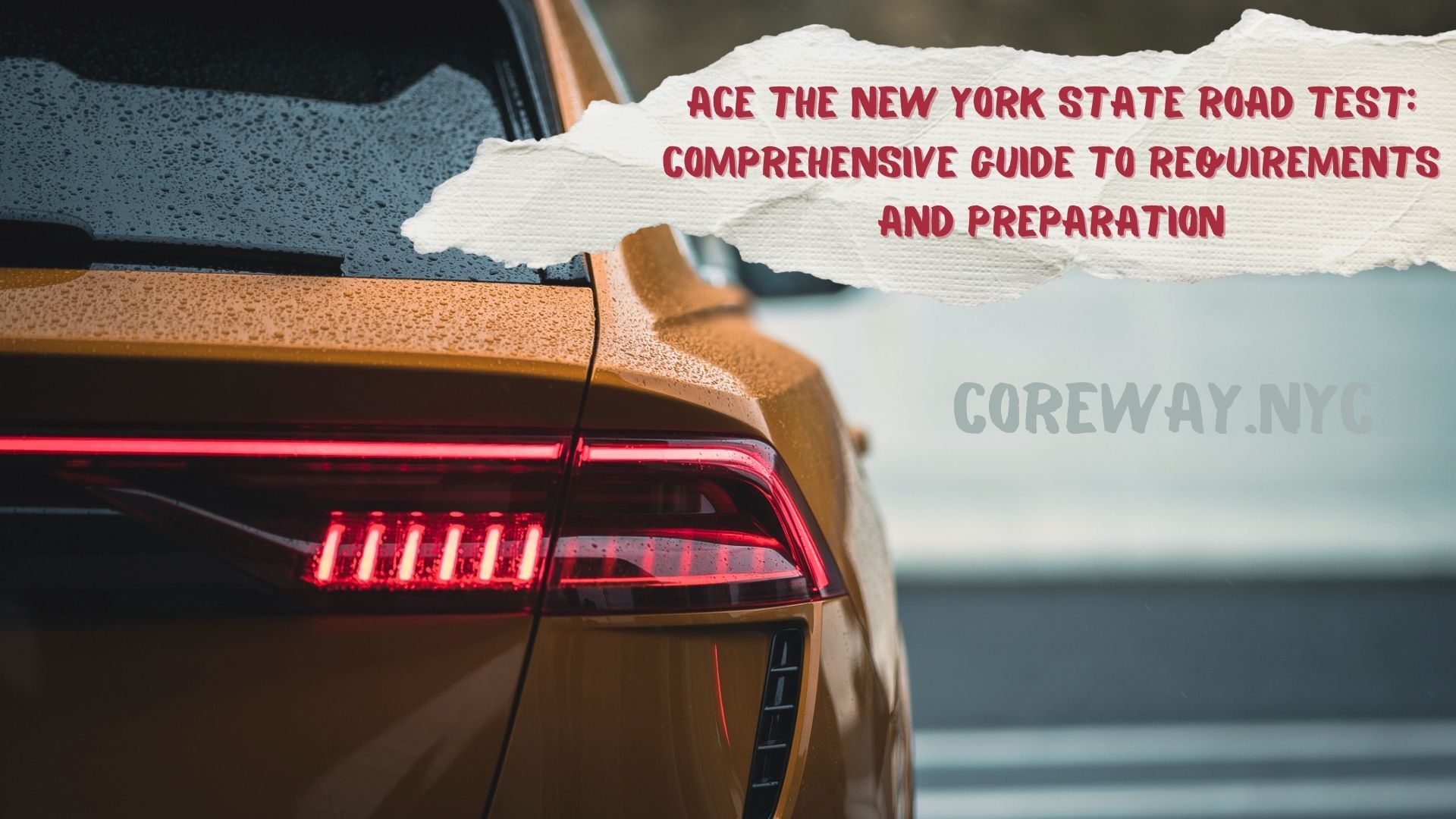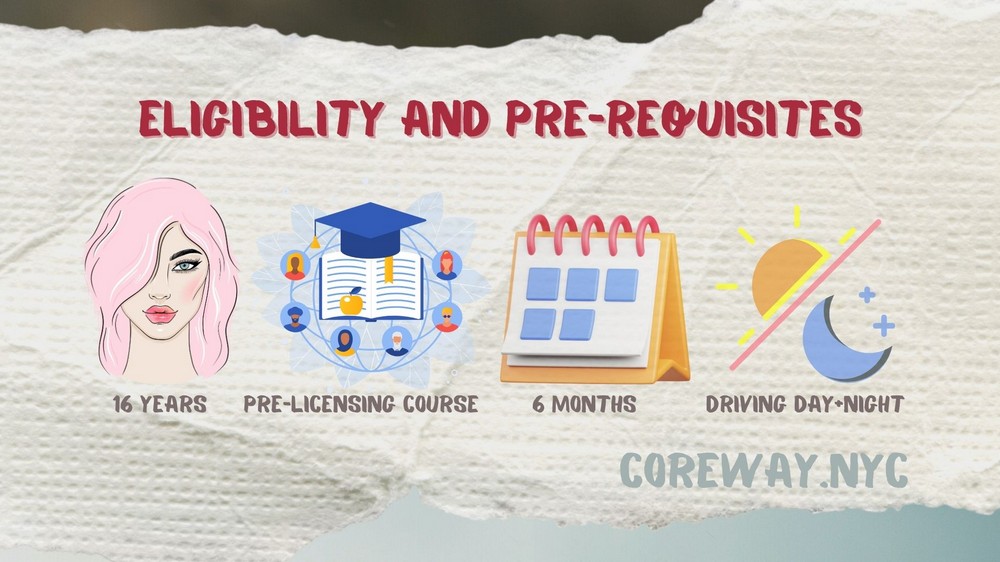Ace the New York State Road Test: Comprehensive Guide to Requirements and Preparation

Table of Contents
Getting your driver’s license is an exciting rite of passage. After months of practicing turns, parallel parking maneuvers, and highway merges, that coveted plastic card represents the freedom to cruise the open roads on your own adventures. However, before enjoying these solo drives, you must first ace the all-important New York State road test.
This comprehensive skills test ensures you have the essential abilities to navigate roads safely. Thorough preparation and practice are crucial for success. This guide will walk you through everything you need to know, from eligibility rules to common mistakes, to pass on your first try.
Learn how to rent a car for road test in Brooklyn and ensure you meet all DMV requirements.
Call Us Today 6AM-10PM
Or fill out the form 24/7
Our team is here to guide you with promotions, instructor availability, and the best training package for you.
Eligibility and Pre-requisites

The New York State Department of Motor Vehicles (DMV) has firm requirements governing who qualifies to take the road test. Table 1 summarizes the key details:
Table 1. Minimum eligibility rules to take the New York State road test
| Minimum Age | 16 years |
| Waiting Period with Learner's Permit | 6 months |
| Course Requirements | Driver's education program or pre-licensing course |
| Practice Driving Hours with Supervision (under 18) | 50 hours, including 15 hours at night |
Drivers must be at least 16 years old before scheduling an exam. The DMV mandates a waiting period of six months from the date when the applicant receives their learner’s permit. This rule provides under-18 drivers time to practice under supervision and demonstrate readiness through a road test.
During this period, completing an approved driver’s education program or pre-licensing course is compulsory. These classes cover road rules and safe driving methods to establish a baseline of knowledge.
For teenage applicants, New York specifies minimum practice driving hours before qualifying for the test, as shown in Table 1. An official MV-262 Certificate of Supervised Driving form signed by the supervising driver must verify meeting these hour thresholds.
With the groundwork laid through supervised practice, pre-licensing education, and months using a learner’s permit, you can schedule the pivotal road test.
Call Us Today 6AM-10PM
Or fill out the form 24/7
Our team is here to guide you with promotions, instructor availability, and the best training package for you.
Booking the Road Test and Test Center Selection
Booking Your Test
You can schedule your road test either:
- Online through the New York DMV website up to eight weeks in advance
- In-person by visiting a local DMV office
When reserving your test online, first create an account on the DMV website. Have your license or learner’s permit number handy for ID verification. The site shows available testing slots at nearby locations over the coming two months.
Select your preferred test center, date, and time. The DMV immediately confirms bookings, displaying your test details on the webpage and emailing a reminder.
You can also schedule road exams in-person up to eight weeks out if slots remain open. Visit a DMV office with an acceptable ID and know your top preferred test date range beforehand.
After you book the road test, immediately add the confirmed date and start time into your calendar. Double check to avoid any scheduling mishaps!
Compare passing rates for all road test sites in Brooklyn before choosing your location.
Choosing the Best Test Location
Schedule your Ditmas Avenue Road Test Appointments today and get ready to pass with confidence at one of Brooklyn's preferred testing locations.
New York has numerous road test sites spanning its vast expanse from Montauk to Niagara. When scheduling your exam, consider location based on:
- Proximity – Most choose the site closest to home to minimize drive time before the test begins. This prevents added nerves or fatigue from long pre-test commutes.
- Appointment availability – All centers have varying testing slot capacity and backlogs. Compromise on distance if your nearest location has no timely openings or long wait lists.
- Test route familiarity – It helps to practice along the actual roads used. If possible, choose a site with a published route to experience those exact streets.
Refer to the DMV road test locations page detailing all 27 test sites statewide. This map helps weigh options based on visibility into available tests and drives.
With your exam scheduled, it is time to prepare the essential documentation.
Essential Documents for the Road Test

Arriving fully prepared with correct paperwork prevents unnecessary delays or cancellations on test day. Be sure to bring all items in this road test documentation checklist:
Table 2. Required documents to provide at the road test
| Document | Details |
| Learner's permit | Original permit card (no photocopies) |
| License application | Form MV-44 completed and signed |
| Proof of insurance | FS-25 form or insurance ID card |
| Vehicle registration | Up-to-date papers for car used in test |
| Vision test report | If applicable based on age and permit type |
You must produce your valid learner’s permit, rather than just quoting the number. Photocopies are not accepted. Bring the completed license application signed by your parent or guardian if under 18.
The DMV reviews current proof of insurance and car registration matching the vehicle make/model. Review expiration dates beforehand. Also, fetch any necessary vision test reports if your age and permit type required one.
With paperwork ready, ensure your test car meets regulations too.
Essential Vehicle Requirements
The car or light truck brought for the road test must meet these baseline safety standards:
- Valid registration and insurance coverage
- Working and properly adjusted seat belts
- No airbag warning lights illuminated
- All lights functional (headlights, brake lights, turn signals, hazard lights)
- No window tinting obstructing interior visibility
- Windshield wipers operational with fluid
- Rearview mirrors present and adjusted appropriately
- No body damage posing safety risks
- Engine running properly with sufficient fuel
- Tires inflated adequately with legal tread depth
Essentially, the test vehicle should be fully functional and roadworthy to ensure a smooth exam. Issues like worn tires, expired registration, or busted tail lights can prompt cancellations. Conduct a thorough pre-test inspection to catch any deficiencies needing repair beforehand.
With a registered, insured vehicle that passes safety checks, shift focus towards honing your driving skills next.
Essential Driving Skills and Techniques
The road test assesses proficiency across core abilities like:
- Safe turning and merging
- Parking, reversing, and three-point turns
- Obeying signs, signals, rights-of-way
- Adjusting speed for conditions
- Yielding to pedestrians and cyclists
- Maintaining control and composure
Practice sessions should emphasize these skills essential for public roads.
Table 3 outlines the key competencies and preparation recommendations.
| Driving Skill | Preparation Tips |
| Parallel parking | Master judging car distances from the curb. Aim for a smooth single motion backwards. |
| Reversing in straight line | Use all mirrors with head checks before reversing more than a car length |
| Three-point turns | Slow with full stops. Check all directions before turning the wheel |
| Left and right turns | Use turn signals every time. Stay in the correct lane position before & after |
| Traffic light stops | Halt before stop lines/crosswalks. No creeping after red lights |
| Yielding right-of-way | Always yield to pedestrians at crossings. Allow other vehicles to merge |
Schedule practice drives during both daylight and nighttime to experience illumination variances. Begin practicing these techniques early, logging extra hours for any struggles. Consistent rehearsal builds muscle memory for instinctively demonstrating safe road habits.
Additional Preparation Tips
Beyond driving practice, also:
- Study road signs, signals, lines, and rules until you interpret their guidance automatically
- Take practice tests online to gauge knowledge gaps needing review
- Practice under varied weather conditions to handle rain, snow, or low visibility confidently
- Get enough rest before the test to concentration fully without fatigue
- Wear comfortable clothing and shoes allowing easy and safe vehicle operation
These well-rounded preparation activities build overall road readiness for responding correctly during the spotlight of your real test.
Common Road Test Mistakes and How to Avoid Them
Despite thorough preparation, nerves sometimes override road skills during tense testing sessions. Monitoring for frequent slip-ups can help consciously prevent them.
Table 4 shows typical mistakes leading to instant test failures:
| Mistake | How to Prevent It |
| Failing to yield right-of-way | Practice scanning and interpreting intersections thoroughly |
| Ignoring traffic signs or signals | Quiz yourself on spotting and obeying all signs |
| Improper turns or lane changes | Perfect mirror checks, signals, positioning each time |
| Exceeding speed limits | Consciously monitor speedometer to avoid creeping up |
| Late or missed braking | Scan farther ahead to react promptly |
Pay special attention to these common pitfalls during practice drives. Discuss any persistent struggles with your supervising driver for extra coaching.
Staying calm and avoiding rushing also minimizes blunders. Play relaxing music and take deep breaths to maintain composure if anxiety spikes.
Conclusion
Obtaining your New York State driver’s license via a passing road test score opens exciting possibilities. Ensure you set yourself up for first-try triumph through diligent preparation.
Follow all the pre-requisites for supervised practice driving and pre-licensing education. Book your test at a convenient location with an optimal appointment. Gather essential documents and conduct a thorough vehicle inspection beforehand.
Most importantly, dedicate time to rehearsing core driving skills reflectively. Seek feedback from supervisors to correct any lingering bad habits. Avoid common mistakes like ignoring signs or improper turns using conscious effort.
With this comprehensive guide’s advice, your road test finish line is now clearly marked for victory. Soon you will confidently cruise towards new adventures with that hard-earned license in hand. Bon voyage!
Please share your own preparation tips and experiences in the comments to encourage fellow new drivers.
Call Us Today 6AM-10PM
Or fill out the form 24/7
Our team is here to guide you with promotions, instructor availability, and the best training package for you.
Frequently asked Questions
-
What are the main risks novice drivers face with muscle cars?
The high horsepower and torque make muscle cars prone to spinning out if throttle inputs are too aggressive. Their stiff suspensions also impact handling compared to regular cars. Newcomers face a steep learning curve to control these performance machines.
-
What skills should beginners focus on when starting out?
Low-speed maneuvering and smoothness should be top priorities initially. Perfect actions like starts, turns, and gear shifts at moderate speeds and RPMs before attempting any fast acceleration or handling. Building foundational competence is crucial.
-
Why are defensive driving classes strongly recommended?
Pre-licensing defensive driving curriculum reinforces cautious habits on public roads. Classes cover key areas like oversteer prevention, increased braking distances, hazards scanning, and weather impacts to traction. They provide critical best practices.
-
What other resources help accelerate skill development?
Advanced one-on-one lessons, track days, and multimedia websites like ASTMuscleCar all offer ways to build competence beyond initial pre-licensing. Well-rounded education combining classroom, experiential, and self-directed learning yields the best abilities.
-
How long does it take to become a highly proficient muscle car driver?
It takes consistent practice over months or years to intuitively handle the unique power of muscle cars in all conditions. Patience and commitment to lifelong learning is required, as there is always room for skill expansion. Avoid overconfidence.
-
What is the worst mistake beginners make behind the wheel?
Giving into temptation and prematurely flooring the throttle leads to loss of control. Attempting high speeds or drifting without mastering basic vehicle control contributes to many crashes. Respect for sheer power is the key mindset for success.
 English
English Spanish
Spanish 

